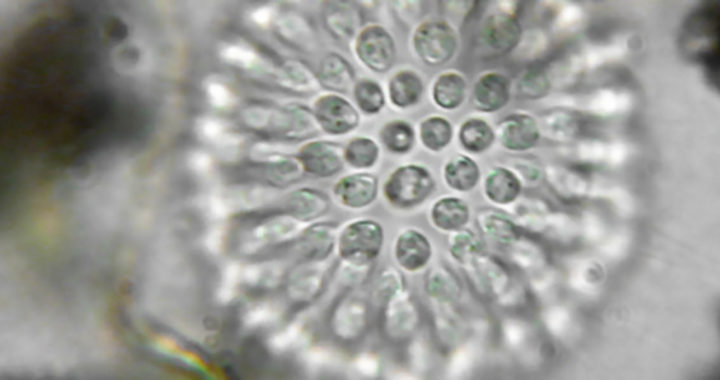German biologist Ernst Haeckel proposed the colonial theory of multicellular life in 1874. He suggested that ancestral metazoans or earlier animals originated from the symbiosis of many organisms of the same unicellular species—as opposed to the symbiotic theory, which suggests symbiosis of different unicellular species resulted in multicellularity.
The colonial theory cited the symbiotic relationship of an ancient species of unicellular flagellate protozoan as an example. This species could live on its own. It could also form a colony with other similar species through a symbiotic relationship. Over time, each cell within the colony became more specialized in structure and functions before gradually losing its individuality. The colony eventually transformed into a multicellular organism.
Several studies and scientific positions have voiced and echoed support for the colonial theory of multicellular life. In fact, a number of researchers have used several models of different unicellular species to explore and understand how an ancient colony of single-celled organisms transitioned into a multicellular organism.
Choanoflagellates as Model for the Colonial Theory of Multicellular Life
Choanoflagellates are regarded as a suitable model for reconstructing the last unicellular ancestor of animals according to a review study and protocol report by Nicole King et al. This group of free-living and colonial eukaryotic unicellular organisms is the closest living relative of animals. Studying the cell biology and genomes of choanoflagellates can provide new insights into metazoan ancestry and origins.
Another study by S. R. Fairclough, M. J. Dayel, and N. King used the colony-forming choanoflagellate S. rosetta to understand the cell biology of colony formation and its potential to the evolution of animal multicellularity.
The study revealed that rosetta colony develops through cellular division rather than cellular aggregation. In other words, the formation of a rosetta colony is dependent on cell proliferation rather than the aggregation or clumping of similar rosetta species in the immediate surroundings.
One of the implications of the aforementioned rosetta colony study is that it supports the Haeckelian view that a colony of unicellular organisms transitioned to a single multicellular organism through repeated cell division. It is also consistent with the hypothesis that the last common ancestor of animals and choanoflagellates was capable of simple multicellularity.
Anderson et al. also used choanoflagellate to determine the mutations that led to the evolution from unicellular to multicellular animal life. They used a technique called ancestral protein reconstruction to move backward in the evolutionary tree and trace the genetic changes that prompted single-celled organisms to evolve a protein critical to multicellular life.
Note that the technique took the researchers to 600 million years ago. They found that a single albeit random mutation resulted in the emergence of a protein that allowed an ancient unicellular organism to form a colony with other similar organisms.
Volvocine Algae as Another Model for Understanding and Proving the Theory
The volvocine green algae or volvox is another model used for studying the colonial theory of multicellular life. This group of algae represents flagellated photosynthetic organisms that range from unicellular and multicellular forms with no cell differentiation or incomplete differentiation to multicellular forms with complete separation.
Researchers M. D. Herren et al. sequenced the DNA of about 45 different species of volvox to reconstruct their family tree and determine how long ago the first colonial ancestor emerged. Results revealed that the ancestors of this group of algae diverged from unicellular and non-colony forming ancestors at least 200 million years ago or during the Triassic period. It took these algae 35 million years to complete the transition.
Throughout the transition, the researchers noted that the volvox formed a multicellular colony while undergoing the cycle of cooperation, conflict, and conflict mediation. Since it diverged from its multicellular ancestors, volvox has evolved into a highly integrated multicellular organism with cellular specialization, a complex developmental program, and a high degree of coordination among cells.
What is interesting to note about this multicellular colony of volvox is that the entire constituents are not a mere cluster of cells with similar functions. Herren and his colleagues emphasize the fact that there is a division of labor within the colony. Some cells do the reproduction while others are involved either in producing a binding substance called extracellular matrix or in swimming or moving and overall survival.
The study of Yuki Arakaki et al. also noted that the Gonium pectorale and Volvox carteri species of volvocine generally have several common morphological features to survive as integrated multicellular organisms. These include having a rotation asymmetry of cells that enables each separate constituent to become components of an entirety or individual and cytoplasmic bridges between protoplasts in developing embryos that maintain the species-specific form of the multicellular individual before secretion of a new extracellular matrix.
FURTHER READINGS AND REFERENCES
- Anderson, D. D. P., Whitney, D. S., Hanson-Smith, V., Woznica, A., Campodonico-Burnett, W., Volkman, B. F., King, N., Thornton, J. W., and Prehoda, K. E. 2016. “Evolution of an Ancient Protein Function Involved in Organized Multicellularity in Animals.” eLife. 5:e10147, DOI: 7554/eLife.10147
- Arakaki, Y., Kawai-Toyooka, H., Hamamura, Y., Higashiyama, T., Noga, A., Hirono, M., Olson, B. J. S. C., and Nozaki, H. 2013. “The Simplest Integrated Multicellular Organism Unveiled.” PLoS ONE. 8(12): e81641. DOI: 1371/journal.pone.0081641
- Fairclough, S. R., Dayel, M. J., and King, N. 2010). “Multicellular Development in a Choanoflagellate.” Current Biology. 20(20): R875-R876. DOI: 1016/j.cub.2010.09.014
- Haeckel, E. 1880. The History or the Development of the Earth and Its Inhabitants by the Action of Natural Causes. Appleton & Co.
- Herron, M. D., Hackett, J. D., Aylward, F. O., and Michod, R. E. 2009. “Triassic Origin and Early Radiation of Multicellular Volvocine Algae.” Proceedings of the National Academy of Sciences. 106(9): 3254-3258. DOI: 1073/pnas.0811205106
- King, N., Young, S. L., Abedin, M., Carr, M., and Leadbeater, B. S. C. 2009. “The Choanoflagellates: Heterotrophic Nanoflagellates and Sister Group of the Metazoa.” Cold Spring Harbor Protocols. 2009(2). DOI: 1101/pdb.emo116
